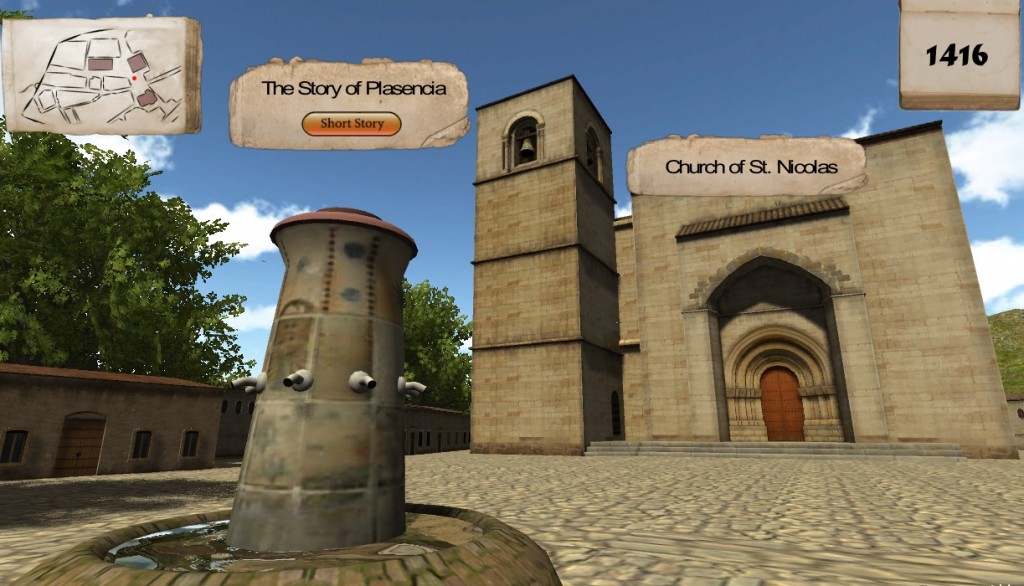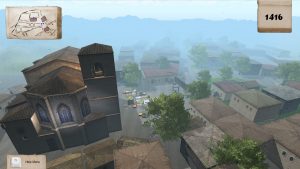Overview of Virtual Plasencia
Virtual Plasencia is a 3D walk-through model of a key portion of the fifteenth century, walled city of Plasencia (Spain). Within this digital world we are revealing the lives and relationships of its Jewish, Catholic, and Muslim inhabitants. Through this virtual space, we aim to recreate the cooperative and challenging processes that emerged during this era of intercultural integration and violence in Spain and Europe. Our team is populating the 3D model with historical narratives that can be discerned by transcribing and evaluating census-like events from Book One (1399-1453) of the Capitulary Acts of the Cathedral of Plasencia, as well as other archival sources.

Screenshot from Virtual Plasencia Version 1.0. The Plaza de San Nicolas.
Our first version of this digital world, also known as Virtual Plasencia, Version 1.0, delivers a portal for the public to immerse themselves within the medieval Plaza de San Nicolas, which was located in the city’s Jewish quarter (juderia). Within this zone, visitors can explore ten historical narratives from the fifteenth century, as well as view the Church of St. Nicholas (Iglesia de San Nicolas), the synagogue (reconstructed using architectural details from other contemporaneous synagogues), and the Palace of the Mirabeles (Palacio de los Mirabeles).
Version 1.0 is our first foray into building a digital Plasencia. Primarily, we have modelled the Plaza de San Nicolas (click to view full image).

The Revealing Cooperation and Conflict Project, the collaborative entity that is digitally recreating this world, assembles geovisualization experts, historians, geographers, linguists, and computer scientists in the U.S.A., Switzerland, and Spain as well as global “citizen scholars”. Additionally, we have secured collaborative agreements and endorsements from key Spanish institutions, including the City of Plasencia (Ayuntamiento de Plasencia); Ministry of Education, Culture, and Sports (Ministerio de Educación, Cultura, y Deportes); and Centro Sefarad Israel. Dr. Roger L. Martinez-Davila serves as the Project Director and Dr. Victor R. Schinazi (Co-PrincipaI Investigator) is the technical leader. For more information, download our more comprehensive storyboard (RCCP Storyboard 10 June 2014).
Virtual Plasencia, Version 1.0 — A Revealing Cooperation and Conflict Project Endeavor
Our project is an international collaboration involving nine universities in Spain, Switzerland, and the United States of America. The project is an independent scholarly endeavor organized within MappaMundi, a digital humanities initiative of the University of Texas at Austin. MappaMundi graciously provided seed-funding for the creation of Virtual Plasencia, as well as ongoing intellectual and technical counsel. MappaMundi is directed by Dr. Geraldine Heng (University of Texas) and Dr. Ece G. Turnator (University of Texas)
Our first version of this 3D world, and the accompanying web portal, is the collaborative work of:
Development Team of Virtual Plasencia, Version 1.0
Dr. Roger L. Martinez-Davila
Dr. Victor R. Schinazi
Ms. Katja Wolff (ETH-Zurich)
Dr. Paddington Hodza
Mr. Skye Swoboda-Colberg
Dr. Ece Turnator (Mappa Mundi, Department of English and General Libraries)
Dr. Colin McAllister
Peer-Review and Beta-Testing of Virtual Plasencia, Version 1.0 (and future hosting of VP V1.0 at the University of Texas)
University of Texas
Mr. Aaron Choate (General Libraries)
Ms. Jade Diaz (General Libraries)
Mr. Ladd Hanson (General Libraries)
Ms. Jennifer Hecker (General Libraries)
Mr. Matthew Villalobos (General Libraries)
Mr. Ethan Persoff (General Libraries